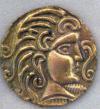Stellar Heavyweight Champion of Dying Stars

Dying stars that cast off their outer envelopes to form the beautiful yet enigmatic “planetary nebulae” (PNe) have a new heavy-weight champion, the innocuously named PNe “BMP1613-5406″. Massive stars live fast and die young, exploding as powerful supernovae after only a few million years.
This is a 30 x 30 arcminute image of NGC6067 & BMP1613-5406. North-East is top left. The image is a B,R,H-alpha tri-colour RGB image (extracted from the online UK Schmidt Telescope SuperCOSMOS H-alpha Survey H-alpha, short-Red (SR) and broad-band ‘B’ images.
Credit: @The University of Hong Kong
But why is this important?
Firstly, PNe provide a unique window into the soul of late stage stellar evolution revealed by their rich emission line spectra that are excellent laboratories for plasma physics. PNe are visible to great distances where their strong lines permit determination of the size, expansion velocity and age of the PN, so probing the physics and timescales of stellar mass loss. They can also be used to derive luminosity, temperature and mass of their central remnant stellar cores, and the chemical composition of the ejected gas.
Secondly, and key here, is that this is an unprecedented example of a star whose proven original “progenitor” mass is close to the theoretical lower limit of core-collapse supernova formation. Our results are the first solid evidence confirming theoretical predictions that 5+ solar mass stars can actually form PNe. This unique case therefore provides the astronomical community with an important tool for fresh insights into stellar and Galactic chemical evolution.
A VPHAS+ combined u g r multi-band ‘RGB’ color image centred on the planetary nebula central star (CS) candidate. The image is 55 x 55 arcseconds in size and the CS is obvious as the sole blue star in the middle of field, located at RA:16h13m02.1s and DEC:-54o06’32.3″ (J2000).
But how did the team from The University of Hong Kong and the University of Manchester claim the heavyweight crown?
The key was the discovery of the PNe in a young, Galactic open cluster called NGC6067. Finding a PNe residing in an open cluster is an extremely rare event. Indeed, only one other PNe, “PHR1615-6555″ has ever been previously proven to reside on an open cluster but whose progenitor star had considerably lower mass. Interestingly, this was an earlier discovery from the same led team as here. The proven location of a PN in a cluster provides key and important data that is difficult to acquire otherwise. This includes an accurate distance and a cluster “turn off” mass estimate (i.e. the mass a star must have had when it was born to now be seen evolving off the main sequence in the cluster of known age). High confidence in the PN-cluster association comes from their highly consistent radial velocities (to better tan 1km/s) in a sight-line with a steep velocity-distance gradient, common distances, common reddening and projected and close physical proximity of the PN to the cluster centre.
A current plot from cluster WDs for the latest IFMR estimates from Cummings et al (2018), together with our estimated point for BMP1613-5406 plotted as a red circle. The only other point from a known OC PN is plotted as a yellow circle (Parker et al 2011). The errors attached to our point reflect the errors in the adopted cluster parameters and the spread of the estimated CS magnitudes.
In summary our exciting results are solid evidence confirming theoretical predictions that 5+ solar mass stars can form planetary nebulae and are, as expected, Nitrogen rich. The PN’s cluster membership provides fresh and tight constraints on the lower mass limit for the progenitor mass of core-collapse supernovae and also for the intermediate to high mass end of the white dwarf Initial to Final Mass Relation (IFMR). It also provides an empirical benchmark for evaluating nucleosynthetic (element creation) predictions for intermediate-mass stars. PN BMPJ1613-5406 and its cluster NGC6067 will provide the astronomical community with important insights into stellar and Galactic (chemical) evolution.
Contacts and sources:
Cindy ChanThe University of Hong Kong
Citation: A high-mass planetary nebula in a Galactic open cluster V. Fragkou, Q. A. Parker, A. A. Zijlstra, L. Crause & H. Barker Nature Astronomy (2019) https://www.nature.com/articles/s41550-019-0796-x http://dx.doi.org/10.1038/s41550-019-0796-x
Source:
Anyone can join.
Anyone can contribute.
Anyone can become informed about their world.
"United We Stand" Click Here To Create Your Personal Citizen Journalist Account Today, Be Sure To Invite Your Friends.
Please Help Support BeforeitsNews by trying our Natural Health Products below!
Order by Phone at 888-809-8385 or online at https://mitocopper.com M - F 9am to 5pm EST
Order by Phone at 866-388-7003 or online at https://www.herbanomic.com M - F 9am to 5pm EST
Order by Phone at 866-388-7003 or online at https://www.herbanomics.com M - F 9am to 5pm EST
Humic & Fulvic Trace Minerals Complex - Nature's most important supplement! Vivid Dreams again!
HNEX HydroNano EXtracellular Water - Improve immune system health and reduce inflammation.
Ultimate Clinical Potency Curcumin - Natural pain relief, reduce inflammation and so much more.
MitoCopper - Bioavailable Copper destroys pathogens and gives you more energy. (See Blood Video)
Oxy Powder - Natural Colon Cleanser! Cleans out toxic buildup with oxygen!
Nascent Iodine - Promotes detoxification, mental focus and thyroid health.
Smart Meter Cover - Reduces Smart Meter radiation by 96%! (See Video).





